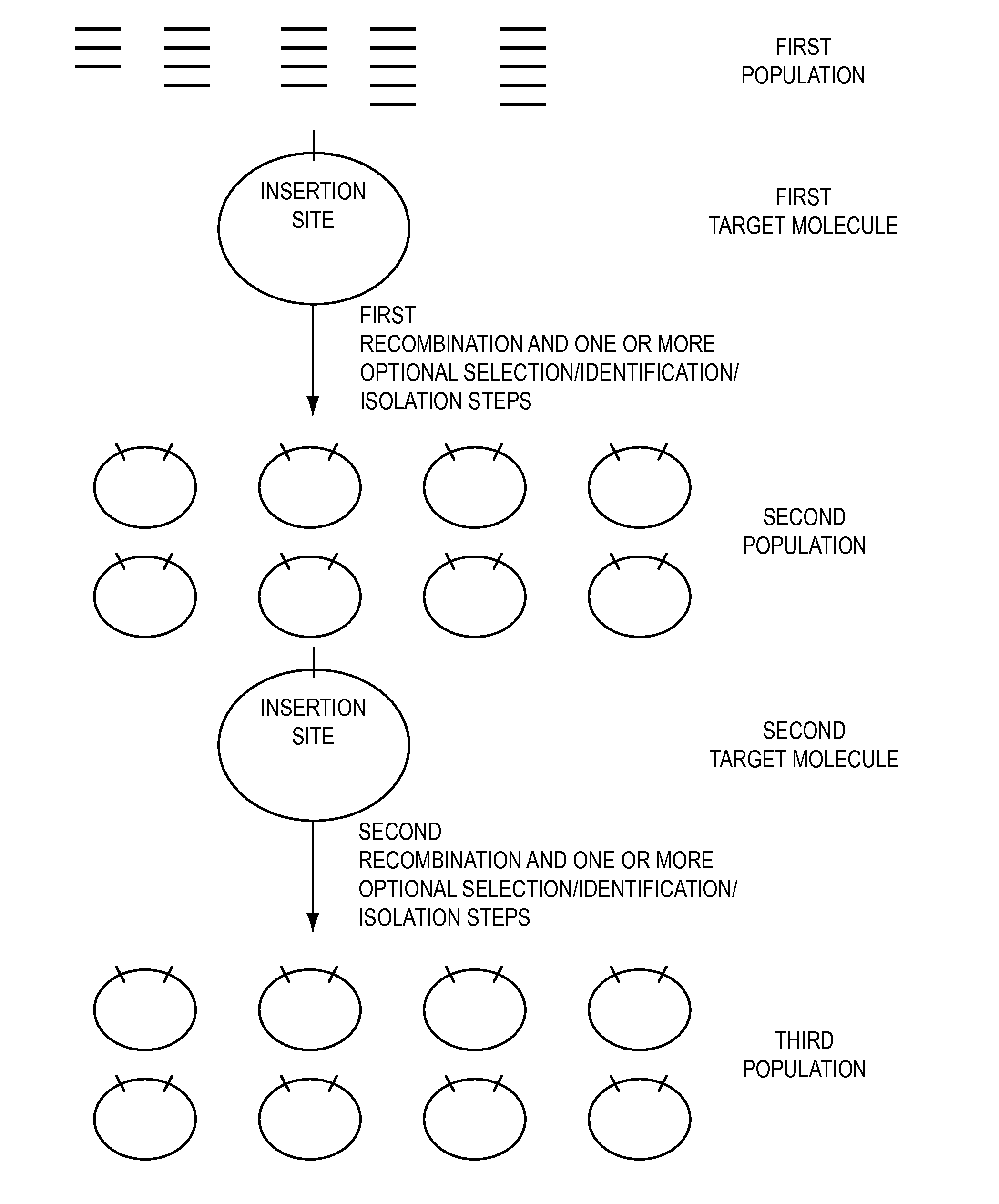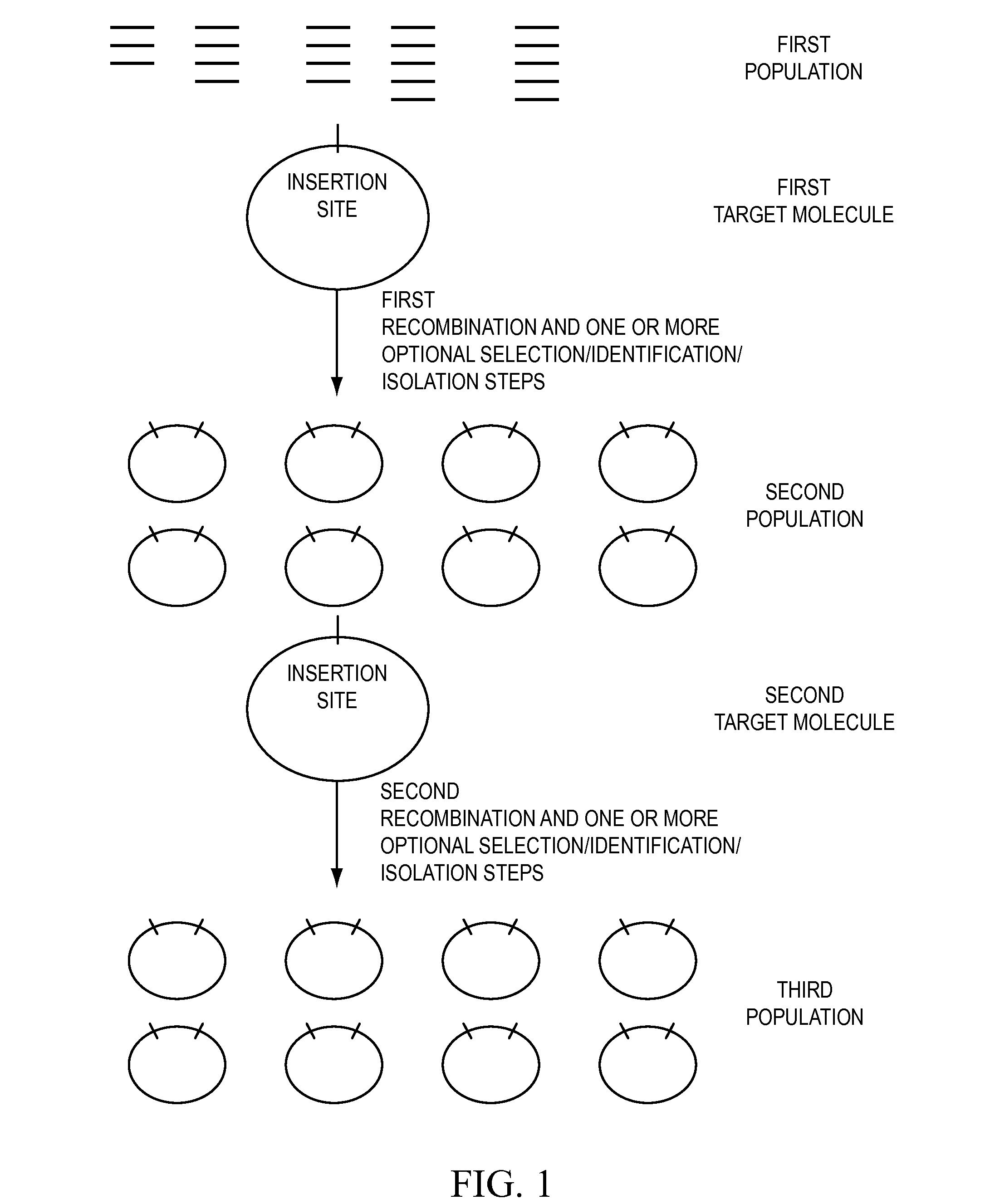Compositions and method for use in isolation of nucleic acid molecules
a nucleic acid and molecule technology, applied in the field of recombinant genetic technology, can solve the problems of wasting a great deal of time and effort in the transfer of dna segments, unable to fully satisfy the needs of recombinant chromosomes, and unable to achieve the effect of recombinant chromosomes, and achieves the effect of powerful and efficient tools
- Summary
- Abstract
- Description
- Claims
- Application Information
AI Technical Summary
Benefits of technology
Problems solved by technology
Method used
Image
Examples
example 1
Simultaneous Cloning of Two Nucleic Acid Segments Using an LR Reaction
[0528]Two nucleic acid segments (either or both of which may be individual members of one or more population of nucleic acid molecules) may be cloned in a single reaction using methods of the present invention. Methods of the present invention may comprise the steps of providing a first nucleic acid segment (e.g., nucleic acid encoding a HIS6 tag) flanked by a first and a second recombination site, providing a second nucleic acid segment (e.g., a member of a cDNA library) flanked by a third and a fourth recombination site, wherein either the first or the second recombination site is capable of recombining with either the third or the fourth recombination site, conducting a recombination reaction such that the two nucleic acid segments are recombined into a single nucleic acid molecule and cloning the single nucleic acid molecule.
[0529]With reference to FIG. 19, two nucleic acid segments flanked by recombination si...
example 2
Use of Suppressor tRNAs to Generate Fusion Proteins
[0563]The recombinational cloning techniques described above permit the rapid movement of nucleic acids (e.g., a member of a cDNA library) flanked by recombination sites from one vector to one or more other vector. Because the recombination event is site specific, the orientation and reading frame of the nucleic acid can be controlled with respect to the vector. This control makes the construction of fusions between sequences present on the nucleic acid inserts and sequences present on the vector a simple matter.
[0564]Site specificity also allows for the joining of multiple nucleic acid segments to form contiguous nucleic acid molecules, and the subsequent insertion of such contiguous molecules into vectors, as well as the transfer of such contiguous molecules between vectors.
[0565]In general terms, nucleic acid may be expressed in four forms: native at both amino and carboxy termini, modified at either end, or modified at both ends...
example 3
Identification of Proteins which Interact with a Known Target Protein
[0580]The DPI protein is known to interact with co-transcription factors of the E2F family, many members of which are known. (See, e.g., Harbour and Dean, Nat. Cell. Biol. 2:E65 (2000); Muller and Helin, Biochim. Biophys. Acta 14:1470 (2000); Ohtani K, Front. Biosci. 1:4 (1999)). The vector pMAB32, which is a derivative of pDBLeu (a yeast two-hybrid vector), contains DNA encoding the full length human DP1 coding region fused at the N-terminus of DP1 to the GAL4 DNA binding domain (Gal4 DB).
[0581]A cDNA library derived from mouse brain RNA was constructed in vector pMAB58. This vector is an RC-compatible E. coli / yeast two-hybrid shuttle vector which contains the Activation Domain of GALA (Ga14 AD). The resulting library fuses the GALA AD to the 5′ end of the cDNA population such that the cDNA is flanked by attB sites (attB1 and attB2: GAL4AD-attB1-cDNA-attB2). It should be noted that because this library contains ra...
PUM
| Property | Measurement | Unit |
|---|---|---|
| molecular weight | aaaaa | aaaaa |
| pH | aaaaa | aaaaa |
| temperatures | aaaaa | aaaaa |
Abstract
Description
Claims
Application Information
 Login to View More
Login to View More - R&D
- Intellectual Property
- Life Sciences
- Materials
- Tech Scout
- Unparalleled Data Quality
- Higher Quality Content
- 60% Fewer Hallucinations
Browse by: Latest US Patents, China's latest patents, Technical Efficacy Thesaurus, Application Domain, Technology Topic, Popular Technical Reports.
© 2025 PatSnap. All rights reserved.Legal|Privacy policy|Modern Slavery Act Transparency Statement|Sitemap|About US| Contact US: help@patsnap.com



